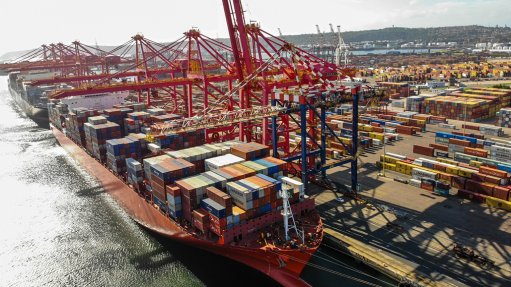Summer storms in Joburg
Johannesburg is a very large city. I’m not sure of the exact dimensions but I think it is at least 1 500 km2. Various cloudbursts which occur all over South Africa vary from Cape Town (continuous and slightly strong to mild) to Durban (brief storms) to many others, but anybody who grew up in Johannesburg knows very well the storms you get in Johannesburg.
I grew up in the north of Johannesburg and had to live through these storms in my youth. A Johannesburg storm consists generally of an outbreak of rain which gets harder and harder until it reaches a peak of some magnitude and which, under some conditions, can be ferocious to a large extent. By ‘ferocious’ I mean the rain pelts down hard and is accompanied by thunder and lightning, which occur at intervals. There is generally no wind. Depending on the magnitude of the storm, there is considerable noise, which can be very frightening. On occasion, the rain and wind turn to sheets of hail that can be very destructive and deafening.
To give an example of the hail, I can remember on numerous occasions during my youth hail storms where the hail reached the size of golf balls or larger. On occasion, the damage to motor vehicles and the roofs of houses was considerable.
When I was younger (just pause for a minute: I am going to stop writing “when I was younger”; you can just assume this all happened when I was younger, since I left Johannesburg in my early twenties) the effect of storms on the power lines in Johannesburg was considerable. I do not know if other parts of the world had their power lines as greatly affected, but we must recall that the height above sea level in Johannesburg is of the order of 5 000 ft. This has the effect of making the air pressure lower than at sea level, which results in more lightning.
Sometime back, the Johannesburg power lines were not designed specifically to cater for the low pressure and, as a result, there were more lightning strikes of a more destructive nature than occurred in other parts of the country and, in fact, in other parts of the world. The average person who grew up or lived in Johannesburg had to be able to withstand or at least put up with lightning strikes which might cause considerable damage. Not only did the strikes cause considerable damage but the knowledge also that the people in Johannesburg had of damage by lightning strikes was not as great as it is now. Growing up in Johannesburg, people just assumed that this is how lightning was and put up with it.
In addition, Eskom was fully aware of the effect of lightning strikes and the damage they could cause, but the utility was not very quick to do anything about it because it was very difficult to get to the point where it had an accurate summary of the strikes. There was a group which did nothing else but investigate lightning strikes and thus created a report which summarised the possible effects of lightning strikes and where they were likely to occur.
It was very difficult to create this report, but it was done. The three scientists who did this work attacked it with all the anticipation and pleasure of a brand-new summary of work which was unique in the world. I can’t remember who they were or what happened to their report. What I remember is that the report was based on lightning strikes which occurred as measured on the chassis of their vehicle and that this was proudly displayed whenever they addressed a group of people about the effect of lightning striking Johannesburg and the area nearby.
But all good things have to come to an end. Eskom and some other people did all their investigations and came to the conclusion that the ideal type of pylons for Johannesburg were of a certain type which could withstand lightning strikes of a certain magnitude. The frequency of lightning on Johannesburg pylons continued as before but the damage they inflicted on power lines reduced. The scientists who had done all the sterling work for lightning strikes were retired. The lightning strikes still continued.
Comments
Press Office
Announcements
What's On
Subscribe to improve your user experience...
Option 1 (equivalent of R125 a month):
Receive a weekly copy of Creamer Media's Engineering News & Mining Weekly magazine
(print copy for those in South Africa and e-magazine for those outside of South Africa)
Receive daily email newsletters
Access to full search results
Access archive of magazine back copies
Access to Projects in Progress
Access to ONE Research Report of your choice in PDF format
Option 2 (equivalent of R375 a month):
All benefits from Option 1
PLUS
Access to Creamer Media's Research Channel Africa for ALL Research Reports, in PDF format, on various industrial and mining sectors
including Electricity; Water; Energy Transition; Hydrogen; Roads, Rail and Ports; Coal; Gold; Platinum; Battery Metals; etc.
Already a subscriber?
Forgotten your password?
Receive weekly copy of Creamer Media's Engineering News & Mining Weekly magazine (print copy for those in South Africa and e-magazine for those outside of South Africa)
➕
Recieve daily email newsletters
➕
Access to full search results
➕
Access archive of magazine back copies
➕
Access to Projects in Progress
➕
Access to ONE Research Report of your choice in PDF format
RESEARCH CHANNEL AFRICA
R4500 (equivalent of R375 a month)
SUBSCRIBEAll benefits from Option 1
➕
Access to Creamer Media's Research Channel Africa for ALL Research Reports on various industrial and mining sectors, in PDF format, including on:
Electricity
➕
Water
➕
Energy Transition
➕
Hydrogen
➕
Roads, Rail and Ports
➕
Coal
➕
Gold
➕
Platinum
➕
Battery Metals
➕
etc.
Receive all benefits from Option 1 or Option 2 delivered to numerous people at your company
➕
Multiple User names and Passwords for simultaneous log-ins
➕
Intranet integration access to all in your organisation


















